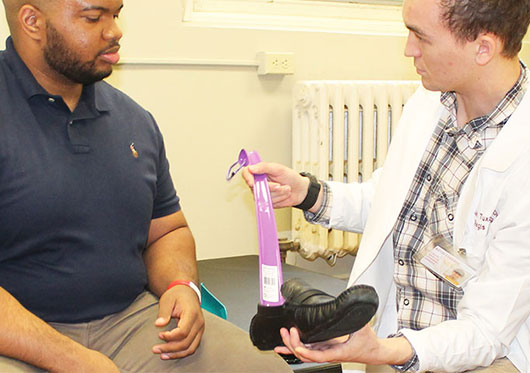If you are considering becoming an occupational therapist, you may be wondering if earning a master’s degree in occupational therapy (MSOT) is worth the investment. In addition to the wide range of career opportunities in the field, occupational therapists can expect job security and generous compensation in exchange for their advanced skills and dedication to patients.
Not only is occupational therapy an in-demand and lucrative career, it is also highly fulfilling and has a true impact on the quality of patient lives. For example, 2016 study found that hospitals that invested in occupational therapy services saw a significant reduction in patients being readmitted. A possible explanation is that occupational therapy addresses the social and functional needs of patients that can be important drivers of readmission if ignored.
“The findings of this important study highlight just one of the many roles occupational therapy practitioners are playing in improving quality and reducing healthcare costs,” said American Occupational Therapy Association Executive Director Fred Somers in a press release.
If you have a genuine interest in impacting the everyday lives of those in need, occupational therapy might be the right career path for you.
Are you considering becoming an occupational therapist, but need some additional information about the career before you can decide if it is the right career choice for you? Below, we explore the salary and job outlook expected for occupational therapists—two important considerations in any job search.
Occupational Therapy Salary
The Bureau of Labor Statistics reported that the median annual wage for occupational therapists was $84,270, or roughly $40.51 per hour, in May 2018. Salaries for these professionals range for a variety of reasons. As such, the lowest 10 percent earned less than $55,490 while the highest 10% earned more than $120,750 in the same year.
There are several factors that influence how much an occupational therapist will earn, including the location and setting in which they work. Top paying industries for occupational therapists to work in include:
- Management of companies and enterprises: $94,170
- Child day care services: $93,720
- Management, scientific, and technical consulting services: $93,370
- Continuing care retirement communities and assisted living facilities for the elderly: $91,900
- Nursing care facilities (Skilled nursing facilities): $90,150
The top paying states for this occupational therapists to practice in include:
- Nevada: $100,970
- New Jersey: $96,600
- California: $95,160
- Arizona: $94,800
- District of Columbia: $94,360
Occupational Therapist Job Outlook
All in all, the occupational therapy industry is projected to maintain strong demand and career opportunities through the next decade and beyond.
Employment of occupational therapists is expected to grow 18 percent between 2018 and 2028, much faster than the average rate of growth for all occupations. As a result, the number of occupational therapy jobs is projected to increase by 23,700 in the same time period.
A driving factor of this growth is the continued importance of skilled occupational therapists for the treatment of people with illnesses and disabilities such as Alzheimer’s disease, cerebral palsy, autism, and other chronic conditions.
The demand for occupational therapists is also expected to climb as the baby boomer generation continues to age. These professionals often play a role in managing ailments associated with aging, such as arthritis and other mobility issues.
The role of occupational therapy is expanding to meet the demand of the aging population by broadening to include more than just rehab. For instance, to accommodate senior citizens who wish to remain independent and live in their own homes, occupational therapists can make modifications to the home and daily routines to reduce the risk of falls and ensure safety.
Employment opportunities for licensed occupational therapists are expected to remain positive in all settings, but particularly in settings where the elderly receive treatment, such as acute hospital, rehabilitation, and orthopedic facilities. Furthermore, those with specialized knowledge in specific treatment areas can expect better job prospects.
To further explain the demand for occupational therapists, the American Occupational Therapy Association (AOTA)’s survey of recent graduates found that the vast majority received their first job offer in less than three months. In addition to receiving offers quickly after graduation, roughly 84 percent of graduates found employment in their preferred practice setting.
Get the Most Out of Your Education
There are so many reasons that people choose to earn an MSOT and start a career as an occupational therapist. These can range from job security and high salaries to professional fulfillment and making an impact.
No matter why you choose to pursue this path, there are several considerations you should bear in mind to get the most out of your education and succeed after graduating.
1. Prepare for the NBCOT
In order to become a licensed occupational therapist, you must graduate from an accredited occupational therapy educational program, complete the necessary fieldwork requirements, and pass the National Board Certification in Occupational Therapy (NBCOT) exam. After each of these steps in complete, you will be able to apply for a license in the state that you wish to practice in.
Preparing for the NBCOT will play a large role in your education if you choose to pursue a career in occupational therapy. Since this certification is required in order to practice, it is important to take advantage of the resources available to you during your training to prepare as much as possible.
At Regis College, the MSOT program is specifically designed with this in mind. The program combines challenging academics, experienced faculty, and community-based experiences and fieldwork opportunities to ensure that students are prepared to pass the NBCOT exam upon graduating.
2. Consider Specializations
As mentioned previously, those who have earned specialized knowledge in specific methods or areas of treatment can often enjoy better job prospects. If you find that you have an interest in a certain aspect of occupational therapy, earning the appropriate board and specialty certifications can pay off in the long run.
The AOTA offers board certifications in the following specialization areas:
- Pediatrics
- Gerontology
- Mental Health
- Physical Rehabilitation
Additionally, specialty certifications are offered in five areas, including:
- Driving and Community Mobility
- Environmental Modification
- Feeding, Eating, and Swallowing
- Low Vision
- School Systems
3. Take Advantage of Fieldwork
Fieldwork is required to obtain licensure, but there are many benefits aside from checking a box off of your to-do list. Level I and Level II fieldwork allows you to gain experience in the occupational therapy field by implementing strategies learned in the classroom to real-world problems in a clinical setting.
Throughout your education, take the opportunity to learn from your fieldwork experiences on a deeper level. As with any profession, hands-on learning will provide you with lessons that can’t be taught in the classroom. Take advantage of these chances to build your skillset and develop your knowledge outside of the classroom throughout your education.
Finding Your Right Fit
If you decide that becoming an occupational therapist is your ultimate career goal, the next step is finding a program that is the right fit for you.
Regis College’s MSOT program is designed to prepare students to excel in the occupational therapy field and build successful careers. A combination of challenging academics and experienced faculty instructors lay the foundational knowledge needed for success in the classroom, while community-based experiences and fieldwork opportunities apply these skills directly to the clinical setting.





